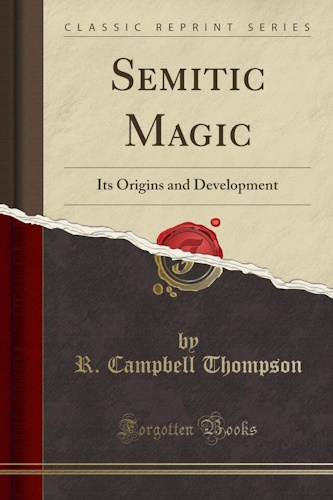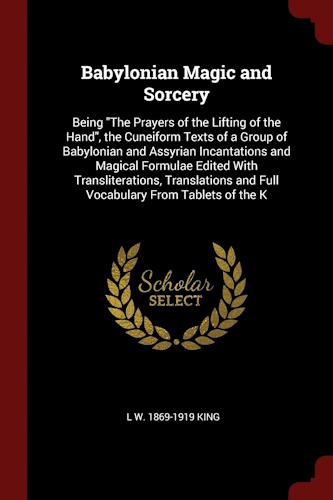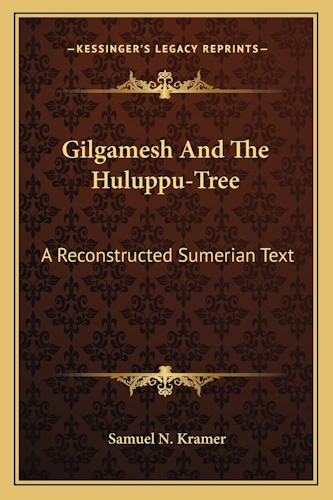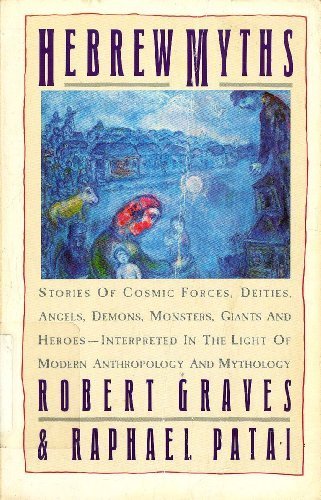![]()
The Lilith Myth
Excerpt from:
Hebrew Myths: The Book of Genesis
(New York: Doubleday, 1964), pp 65-69
by
Robert Graves and Raphael Patai
![]()

The Lilith Myth
Hebrew Myths: The Book of Genesis 
Hebrew Myths: The Book of Genesis
Presented here is a chapter discussing Lilith, taken from Hebrew Myths: The Book of Genesis by Robert Graves and Raphael Patai (New York: Doubleday, 1964), pp 65-69. Graves and Patai have collected traditional Hebrew myths that amplify (and sometimes radically alter) stories found in the Book of Genesis. This chapter, titled "Adam's Helpmeets", deals in part with the Lilith myth. Each section of the chapter excerpted here recounts a "story" collected from non-biblical sources, frequently the Talmud -- sources are footnoted. The footnotes are followed by notes of author commentary. Hebrew Myths is recently back in print in a new hardcover edition -- Buy the Book
. (A much more extensive discussion of Lilith is found in the The Hebrew Goddess, also by Rapael Patai. The Hebrew Goddess is in print and is listed next....)
The Hebrew Goddess The Hebrew Goddess

The best detailed discussion and historical evaluation of the Lilith myth will be found in The Hebrew Goddess, by Raphael Patai (Wayne State University Press, 3rd edition, 1978). Patai presents an in-depth evaluation of the important but oft ignored role played by the feminine in Hebrew myth and religion, following the story of the Hebrew goddess from antiquity through its manifestations in Kabbalah and in the developing myth of Lilith. We highly recommend this work to those interested in the story of Lilith. Click here to Buy the Book
Those interested in the Lilith myth might also find interesting an essay discussing Gnostic creation mythology and the important role played by the feminine in the unique Gnostic reading of the Book of Genesis: The Genesis Factor: Gnostic Creation Mythology.
Excerpt from:
Hebrew Mythsby Robert Graves and Raphael Patai (New York: Doubleday, 1964), pp 65-69
Chapter 10: Adam's Helpmeets
(a) Having decided to give Adam a helpmeet lest he should be alone of his kind, God put him into a deep sleep, removed one of his ribs, formed it into a woman, and closed up the wound, Adam awoke and said: 'This being shall be named "Woman", because she has been taken out of man. A man and a woman shall be one flesh.' The title he gave her was Eve, 'the Mother of All Living''. [1]
(b) Some say that God created man and woman in His own image on the Sixth Day, giving them charge over the world; [2] but that Eve did not yet exist. Now, God had set Adam to name every beast, bird and other living thing. When they passed before him in pairs, male and female, Adam-being already like a twenty-year-old man-felt jealous of their loves, and though he tried coupling with each female in turn, found no satisfaction in the act. He therefore cried: 'Every creature but I has a proper matel', and prayed God would remedy this injustice. [3]
(c) God then formed Lilith, the first woman, just as He had formed Adam, except that He used filth and sediment instead of pure dust. From Adam's union with this demoness, and with another like her named Naamah, Tubal Cain's sister, sprang Asmodeus and innumerable demons that still plague mankind. Many generations later, Lilith and Naamah came to Solomon's judgement seat, disguised as harlots of Jerusalem'. [4]
(d) Adam and Lilith never found peace together; for when he wished to lie with her, she took offence at the recumbent posture he demanded. 'Why must I lie beneath you?' she asked. 'I also was made from dust, and am therefore your equal.' Because Adam tried to compel her obedience by force, Lilith, in a rage, uttered the magic name of God, rose into the air and left him.
Adam complained to God: 'I have been deserted by my helpmeet' God at once sent the angels Senoy, Sansenoy and Semangelof to fetch Lilith back. They found her beside the Red Sea, a region abounding in lascivious demons, to whom she bore lilim at the rate of more than one hundred a day. 'Return to Adam without delay,' the angels said, `or we will drown you!' Lilith asked: `How can I return to Adam and live like an honest housewife, after my stay beside the Red Sea?? 'It will be death to refuse!' they answered. `How can I die,' Lilith asked again, `when God has ordered me to take charge of all newborn children: boys up to the eighth day of life, that of circumcision; girls up to the twentieth day. None the less, if ever I see your three names or likenesses displayed in an amulet above a newborn child, I promise to spare it.' To this they agreed; but God punished Lilith by making one hundred of her demon children perish daily; [5] and if she could not destroy a human infant, because of the angelic amulet, she would spitefully turn against her own. [6]
(e) Some say that Lilith ruled as queen in Zmargad, and again in Sheba; and was the demoness who destroyed Job's sons. [7] Yet she escaped the curse of death which overtook Adam, since they had parted long before the Fall. Lilith and Naamah not only strangle infants but also seduce dreaming men, any one of whom, sleeping alone, may become their victim. [8]
(f) Undismayed by His failure to give Adam a suitable helpmeet, God tried again, and let him watch while he built up a woman's anatomy: using bones, tissues, muscles, blood and glandular secretions, then covering the whole with skin and adding tufts of hair in places. The sight caused Adam such disgust that even when this woman, the First Eve, stood there in her full beauty, he felt an invincible repugnance. God knew that He had failed once more, and took the First Eve away. Where she went, nobody knows for certain. [9]
(g) God tried a third time, and acted more circumspectly. Having taken a rib from Adam's side in his sleep, He formed it into a woman; then plaited her hair and adorned her, like a bride, with twenty-four pieces of jewellery, before waking him. Adam was entranced. [10]
(h) Some say that God created Eve not from Adam's rib, but from a tail ending in a sting which had been part of his body. God cut this off, and the stump-now a useless coccyx-is still carried by Adam's descendants. [11]
(i) Others say that God's original thought had been to create two human beings, male and female; but instead He designed a single one with a male face looking forward, and a female face looking back. Again He changed His mind, removed Adam's backward-looking face, and built a woman's body for it. [12]
(j) Still others hold that Adam was originally created as an androgyne of male and female bodies joined back to back. Since this posture made locomotion difficult, and conversation awkward, God divided the androgyne and gave each half a new rear. These separate beings He placed in Eden, forbidding them to couple. [13]
Authors' Comments on the Myth:
1. The tradition that man's first sexual intercourse was with animals, not women, may be due to the widely spread practice of bestiality among herdsmen of the Middle East, which is still condoned by custom, although figuring three times in the Pentateuch as a capital crime. In the Akkadian Gilgamesh Epic, Enkidu is said to have lived with gazelles and jostled other wild beasts at the watering place, until civilized by Aruru's priestess. Having enjoyed her embraces for six days and seven nights, he wished to rejoin the wild beasts but, to his surprise, they fled from him. Enkidu then knew that he had gained understanding, and the priestess said: 'Thou art wise, Enkidu, like unto a god!'
2. Primeval man was held by the Babylonians to have been androgynous. Thus the Gilgamesh Epic gives Enkidu androgynous features: `the hair of his head like a woman's, with locks that sprout like those of Nisaba, the Grain-goddess.' The Hebrew tradition evidently derives from Greek sources, because both terms used in a Tannaitic midrash to describe the bisexual Adam are Greek: androgynos, 'man-woman', and diprosopon, 'twofaced'. Philo of Alexandria, the Hellenistic philosopher and commentator on the Bible, contemporary with Jesus, held that man was at first bisexual; so did the Gnostics. This belief is clearly borrowed from Plato. Yet the myth of two bodies placed back to back may well have been founded on observation of Siamese twins, which are sometimes joined in this awkward manner. The two-faced Adam appears to be a fancy derived from coins or statues of Janus, the Roman New Year god.
3. Divergences between the Creation myths of Genesis r and n, which allow Lilith to be presumed as Adam's first mate, result from a careless weaving together of an early Judaean and a late priestly tradition. The older version contains the rib incident. Lilith typifies the Anath-worshipping Canaanite women, who were permitted pre-nuptial promiscuity. Time after time the prophets denounced Israelite women for following Canaanite practices; at first, apparently, with the priests' approval-since their habit of dedicating to God the fees thus earned is expressly forbidden in Deuteronomy XXIII. 18. Lilith's flight to the Red Sea recalls the ancient Hebrew view that water attracts demons. 'Tortured and rebellious demons' also found safe harbourage in Egypt. Thus Asmodeus, who had strangled Sarah's first six husbands, fled 'to the uttermost parts of Egypt' (Tobit viii. 3), when Tobias burned the heart and liver of a fish on their wedding night.
4. Lilith's bargain with the angels has its ritual counterpart in an apotropaic rite once performed in many Jewish communities. To protect the newborn child against Lilith-and especially a male, until he could be permanently safeguarded by circumcision-a ring was drawn with natron, or charcoal, on the wall of the birthroom, and inside it were written the words: 'Adam and Eve. Out, Lilith!' Also the names Senoy, Sansenoy and Semangelof (meanings uncertain) were inscribed on the door. If Lilith nevertheless succeeded in approaching the child and fondling him, he would laugh in his sleep. To avert danger, it was held wise to strike the sleeping child's lips with one finger-whereupon Lilith would vanish.
5. 'Lilith' is usually derived from the Babylonian-Assyrian word lilitu, ,a female demon, or wind-spirit'-one of a triad mentioned in Babylonian spells. But she appears earlier as 'Lillake' on a 2000 B.G. Sumerian tablet from Ur containing the tale of Gilgamesh and the Willow Tree. There she is a demoness dwelling in the trunk of a willow-tree tended by the Goddess Inanna (Anath) on the banks of the Euphrates. Popular Hebrew etymology seems to have derived 'Lilith' from layil, 'night'; and she therefore often appears as a hairy night-monster, as she also does in Arabian folklore. Solomon suspected the Queen of Sheba of being Lilith, because she had hairy legs. His judgement on the two harlots is recorded in I Kings III. 16 ff. According to Isaiah xxxiv. I4-I5, Lilith dwells among the desolate ruins in the Edomite Desert where satyrs (se'ir), reems, pelicans, owls, jackals, ostriches, arrow-snakes and kites keep her company.
6. Lilith's children are called lilim. In the Targum Yerushalmi, the priestly blessing of Numbers vi. 26 becomes: 'The Lord bless thee in all thy doings, and preserve thee from the Lilim!' The fourth-century A.D. commentator Hieronymus identified Lilith with the Greek Lamia, a Libyan queen deserted by Zeus, whom his wife Hera robbed of her children. She took revenge by robbing other women of theirs.
7. The Lamiae, who seduced sleeping men, sucked their blood and ate their flesh, as Lilith and her fellow-demonesses did, were also known as Empusae, 'forcers-in'; or Mormolyceia, 'frightening wolves'; and described as 'Children of Hecate'. A Hellenistic relief shows a naked Lamia straddling a traveller asleep on his back. It is characteristic of civilizations where women are treated as chattels that they must adopt the recumbent posture during intercourse, which Lilith refused. That Greek witches who worshipped Hecate favoured the superior posture, we know from Apuleius; and it occurs in early Sumerian representations of the sexual act, though not in the Hittite. Malinowski writes that Melanesian girls ridicule what they call `the missionary position', which demands that they should lie passive and recumbent.
8. Naamah, 'pleasant', is explained as meaning that 'the demoness sang pleasant songs to idols'. Zmargad suggest smaragdos, the semi-precious aquamarine; and may therefore be her submarine dwelling. A demon named Smaragos occurs in the Homeric Epigrams.
9. Eve's creation by God from Adam's rib-a myth establishing male supremacy and disguising Eve's divinity-lacks parallels in Mediterranean or early Middle-Eastern myth. The story perhaps derives iconotropically from an ancient relief, or painting, which showed the naked Goddess Anath poised in the air, watching her lover Mot murder his twin Aliyan; Mot (mistaken by the mythographer for Yahweh) was driving a curved dagger under Aliyan's fifth rib, not removing a sixth one. The familiar story is helped by a hidden pun on tsela, the Hebrew for 'rib': Eve, though designed to be Adam's helpmeet, proved to be a tsela, a 'stumbling', or 'misfortune'. Eve's formation from Adam's tail is an even more damaging myth; perhaps suggested by the birth of a child with a vestigial tail instead of a coccyx-a not infrequent occurrence.
10. The story of Lilith's escape to the East and of Adam's subsequent marriage to Eve may, however, record an early historical incident: nomad herdsmen, admitted into Lilith's Canaanite queendom as guests (see 16. 1), suddenly seize power and, when the royal household thereupon flees, occupy a second queendom which owes allegiance to the Hittite Goddess Heba.
The meaning of 'Eve' is disputed. Hawwah is explained in Genesis III. 20 as 'mother of all living'; but this may well be a Hebraicized form of the divine name Heba, Hebat, Khebat or Khiba. This goddess, wife of the Hittite Storm-god, is shown riding a lion in a rock-sculpture at Hattusas which equates her with Anath-and appears as a form of Ishtar in Hurrian texts. She was worshipped at Jerusalem (see 27. 6). Her Greek name was Hebe, Heracles's goddess-wife.
--Hebrew Myths
by Robert Graves and Raphael Patai (New York: Doubleday, 1964), pp 65-69. Click here to Buy the Book
Footnotes
[1] Genesis II. 18-25; III. 20.
[2] Genesis I. 26-28.
[3] Gen. Rab. 17.4; B. Yebamot 632.
[4] Yalqut Reubeni ad. Gen. II. 21; IV. 8.
[5] Alpha Beta diBen Sira, 47; Gaster, MGWJ, 29 (1880), 553 ff.
[6] Num. Rab. 16.25.
[7] Targum ad job 1. 15.
[8] B. Shabbat 151b; Ginzberg, LJ, V. 147-48.
[9] Gen. Rab. 158, 163-64; Mid. Abkir 133, 135; Abot diR. Nathan 24; B. Sanhedrin 39a.
[10] Gen. II. 21-22; Gen. Rab. 161.
[11] Gen. Rab. 134; B. Erubin 18a.
[12] B. Erubin 18a.
[13] Gen. Rab. 55; Lev. Rab. 14.1: Abot diR. Nathan 1.8; B. Berakhot 61a; B. Erubin 18a; Tanhuma Tazri'a 1; Yalchut Gen. 20; Tanh. Buber iii.33; Mid. Tehillim 139, 529.
![]()
![]()
Disclaimer:
Some material presented will contain links, quotes, ideologies, etc., the contents of which should be understood to first, in their whole, reflect the views or opinions of their editors, and second, are used in my personal research as "fair use" sources only, and not espousement one way or the other. Researching for 'truth' leads one all over the place...a piece here, a piece there. As a researcher, I hunt, gather and disassemble resources, trying to put all the pieces into a coherent and logical whole. I encourage you to do the same. And please remember, these pages are only my effort to collect all the pieces I can find and see if they properly fit into the 'reality aggregate'.
Personal Position:
I've come to realize that 'truth' boils down to what we 'believe' the facts we've gathered point to. We only 'know' what we've 'experienced' firsthand. Everything else - what we read, what we watch, what we hear - is what someone else's gathered facts point to and 'they' 'believe' is 'truth', so that 'truth' seems to change in direct proportion to newly gathered facts divided by applied plausibility. Though I believe there is 'truth', until someone representing the celestial realm visibly appears and presents the heavenly records of Facts And Lies In The Order They Happened, I can't know for sure exactly what "the whole truth' on any given subject is, and what applies to me applies to everyone. Until then I'll continue to ask, "what does The Urantia Book say on the subject?"
~Gail Bird Allen
![]()
![]()




















